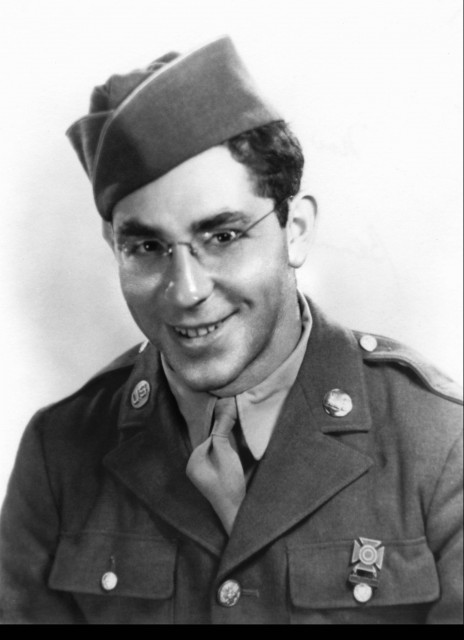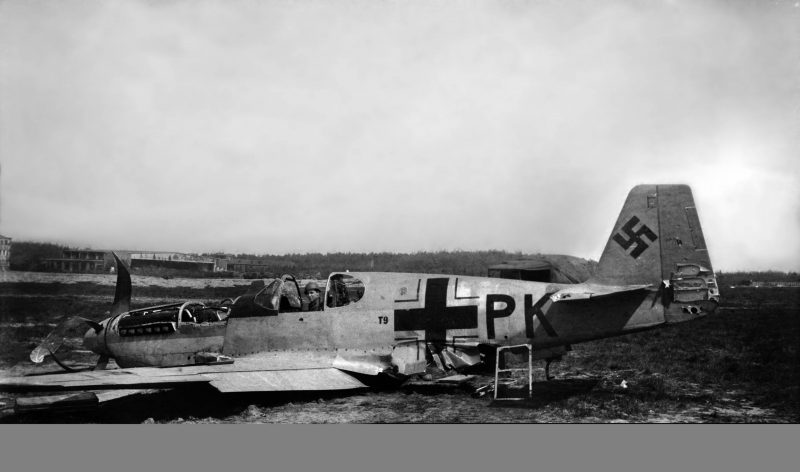

Biagio Castiglione in Nov 1943. He’s 20 years old. He was a Combat Engineer at the Corps level and mostly drove trucks. A regular GI, h always had a camera with him and would take photos of anything that caught his eye.
He had trouble finding film in the combat zones so he’d try to find some in liberated Paris when he drove to get supplies or was a driver for an officer. Some he got developed by the Army, probably at a medical or intel unit but most rolls were just mailed home to be developed when he got back.
These pictures have never before been seen on the internet, they’ve been in photo albums for 70 years, War History Online is proud to publish them for the first time!
Basic Training
It’s 1943 and they are at Camp Swift, Texas going through basic training. This is Biagio with a M1 Carbine. The barracks are behind him.
Biagio holding an M1 Garand. His friend is holding a Thompson Submachine Gun. He foolishly has his finger on the trigger. Luckily, the Army didn’t trust anyone with ammo unless they were at the range or in theater. This photo shows a better view of the training barracks.
England and France
Biagio Castiglione is standing at the far left
Biagio took this pictures after, what was left of, St Lo was liberated.. A bulldozer clears a road through the rubble. Note the church steeple.
Trucks carrying supplies from the beach to the front.
Another cleared road.
Biagio on Kitchen Patrol. The water heaters sit in the garbage cans and the men swished their mess kits in the water to clean them after eating. The markings on the trailer show 9th Army 1115th Combat Engineers.
Germany
Sturmtiger
A destroyed Panzer Mk IV
Biagio Castiglione is on the left. The guy on the right is not identified. Note the camera case strap around his neck. It looks like a tire change on an 1115th Engineers staff car.
There’s a dog around that looks healthy. With the starvation going on, a dog was a rarity, a luxury, and even a food source. It looks like bullet marks on the wall from an earlier fight. The jeep has a unit modified bar in front to counter cables strung across roads to catch drivers in the neck.
A North American P-51B or C model with a swastika on the tail. (The more advanced D Model had a bubble canopy and a lower fuselage top behind it.) Biagio sitting in the cockpit pretending he’s the Red Baron.
Two more pictures of, what appears to be, a BF-109
The name on the truck at the right is “Collie”, Biagios Dodge WC 51 was named after his girlfriend who became his wife after the war.
The next three photos were taken in Ulm, Germany. The huge cathedral there was amazingly undamaged and you could climb up stairs to the top. My dad was in full tourist mode and took scenes of the rubble below.
Here’s the view of Ulm from the top of the cathedral. You can see the main roads cleared by engineer bulldozers to make it easier to move around the city center. Most of the wooden roofs are burned away leaving hollowed out brick structures.
Here’s a lower level view of Ulm’s rubble.
The notes on this packet of negatives says, “Koblenz (Coblenz) – Pontoon bridge & Fortress.” The XIX Corps built 15 bridges across the Rohr and I’m guessing this one across the Rhine.
Here’s a Bailey Bridge under construction by engineers. Unfortunately, the notes on the envelope containing this negative did not match what was on the negatives inside. I’m pretty sure this is Biagio’s Engineering unit though.
This photo is the farthest east they got when they met up with the Soviets on the other side of the Elbe River at Magdeburg. The Truman Bridge was built by the 295th Combat Engineers which is my Biagio’s sister unit in the XIX Corps. They were divided into 4 units before they came ashore in Normandy.
An American Cemetery
Going Home
Biagio (on the right) and two friends on the Riviera waiting for a ship back to the states. He arrived home to Niagara Falls in December 1945. I gave him a lot of grief for having the worst shined boots in the group. Note his camera case on his hip. Also note the Kodak film sign on the lower left. These photos were shot on Kodak’s Panatomic film.
Going home. Biagio got home to Niagara Falls in December 1945. He left out of southern France on a Liberty Ship. The top photo is passing Gibraltar. You can see another Liberty Ship with the rock of Gibraltar behind them.
The men on the deck. Biagio is seated outside the safety rail with his nose just above the bar. Later he told stories about rough seas making everyone puke. I guess it’s worth it if you’re going home.




Leave a Comment